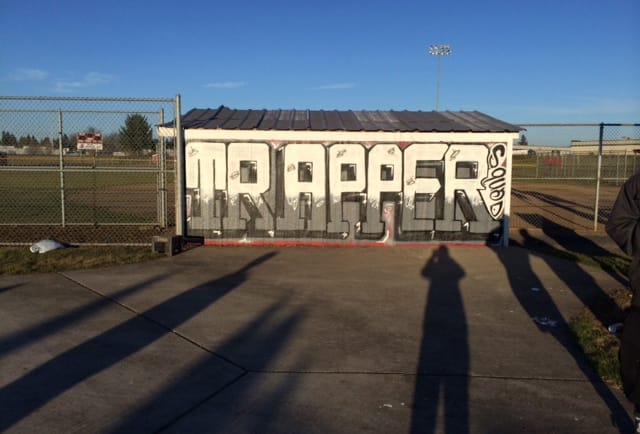When the softball coach at Fort Vancouver High School asked students to create artwork for the school’s softball dugout, the teens gathered cans of spray paint last weekend and went to work.
But the mural they created is likely to be painted over because it wasn’t approved ahead of time, Vancouver Public Schools officials said. Crystal Wallace, the school’s softball coach, said one Fort official worried the graffiti-style mural the students created could be interpreted as gang-related.
In shaded block letters, the mural spells out “Trapper,” the name of Fort’s mascot. It’s done in red and white, the school’s colors. A group of about six students finished the mural Sunday. In all, it took them roughly six hours and six cans of spray paint to pull it off.
“I was really excited,” Wallace said. “The kids were using their art in a good, positive way.”
Wallace said one of the students involved in the mural is in the school district’s Back on Track program for at-risk youth. The program, which Wallace works for, allows expelled students to learn how their actions impact themselves and others.
Wallace said one of the student artists told her: “‘This is our dream, to be noticed for our artwork.'”
Approval process
School officials aren’t as excited about the project.
“It’s great artwork,” said Fort Vancouver Principal Scott Parker. “But in this district, any alterations to buildings needs to go through an approval process. It didn’t go through any approval process.”
In this instance, the approval process should have started with the school’s athletic director, Dirk Hansen, who then likely would have shown the proposed artwork to the principal, Parker said.
“That never happened,” Parker said. “We’re investigating why it got to this point.”
One of the student artists, 17-year-old Fort Vancouver senior Dominic DiGiorgio Acosta, said he asked Wallace if it was OK for the students to paint the mural, and she said yes. “I don’t know why it’s not OK,” he added.
He said on Facebook that he felt “blessed” to have the chance to paint the mural with his friends.
His mother, Andreana DiGiorgio, said Dominic was “really excited” to get to participate in the project, but that she worried he could get in trouble for painting the dugout.
“You think the softball coach would know there are appropriate channels to be approved,” she said.
Wallace said Wednesday afternoon that she wasn’t aware of the process she needed to go through.
Pat Mattison, the district’s spokeswoman, requested The Columbian not go to the school, photograph the mural or write a story about the incident.
‘A good thing’
The controversy has caused a buzz at the high school.
“I don’t know why the school is freaking out about it. It’s art,” said Fort Vancouver junior Freddy Giovanni Hill-Avila, 16. “She (Wallace) said it was perfectly fine for us to be there.”
Freddy said the mural was well-received.
“Around school people were talking about it. That it was a good thing,” he said.
A similar incident regarding artwork created by Fort Vancouver students occurred in May after vandals decapitated the iconic Wendy Rose statue along the Columbia River waterfront near Beaches Restaurant.
Without going through the district’s approval process, some students created a temporary metal head that looked like Bender, a robot character from the animated television series “Futurama,” and attached it to Wendy Rose.
City officials had the student-made head removed. Later, Wendy Rose’s head was replaced by one made by the statue’s original artist.





